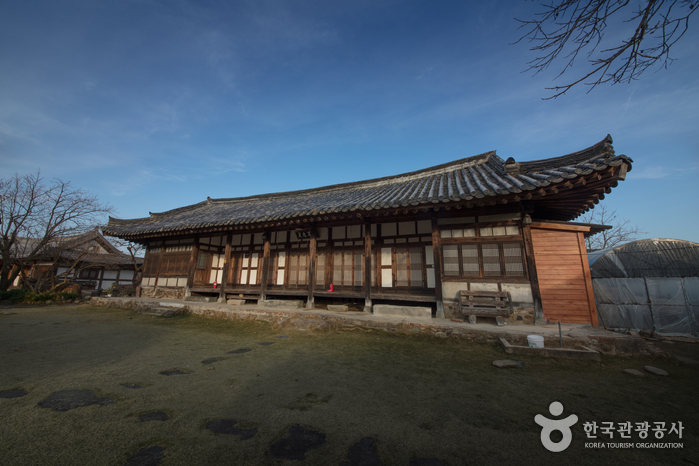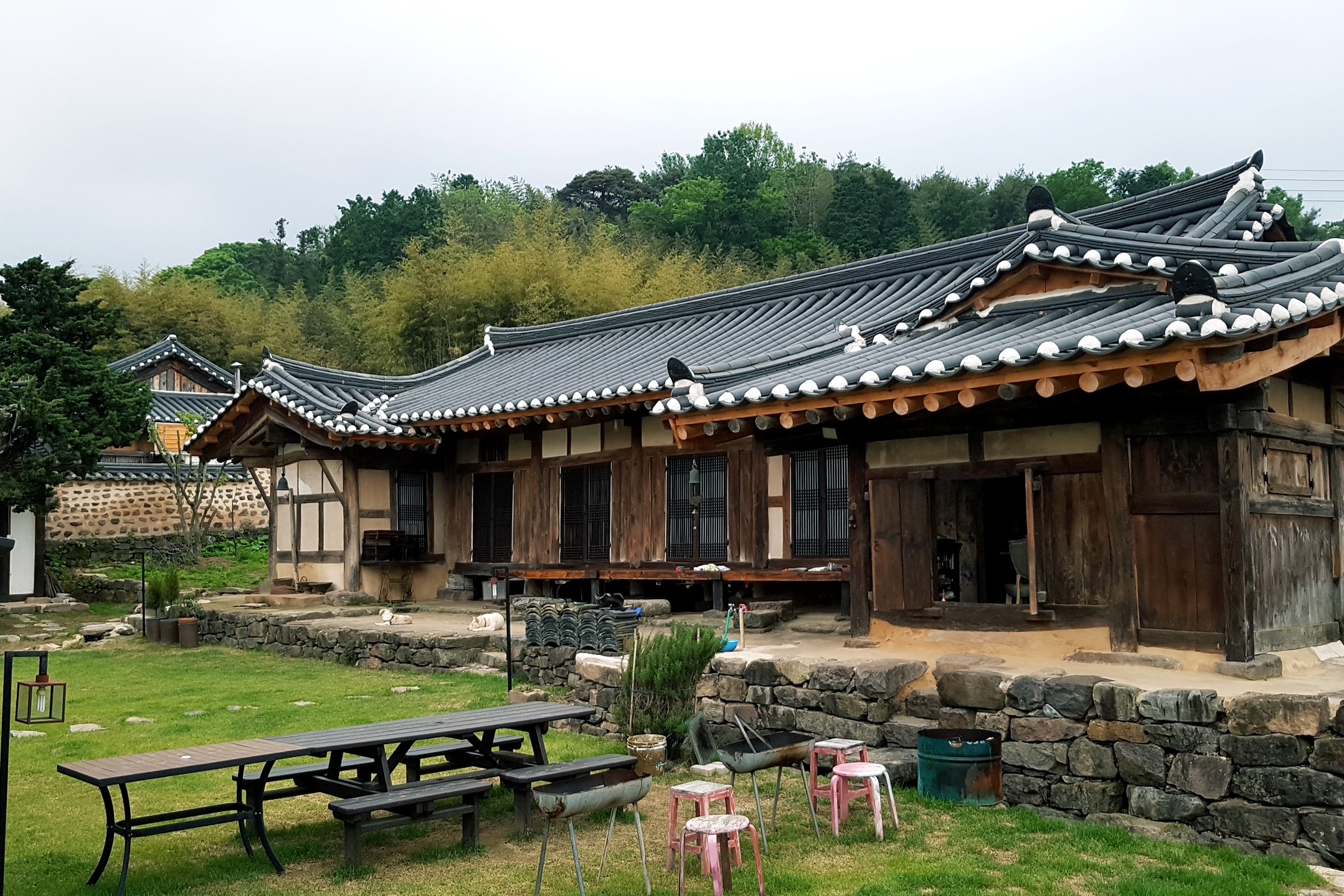Aldea Samjinae de Changpyeong en Damyang (Cittaslow) (담양 창평 삼지내마을[슬로시티])
18.4Km 2021-06-25
Doldam-gil 9-22, Changpyeong-myeon, Damyang-gun, Jeollanam-do.
La Aldea Samjinae es una zona residencial formada en 1510. En su parte este hay una montaña llamada Wolbongsan, y desde el famoso pico Guksubong del sur se puede observar la entera aldea. Su nombre significa “Aldea en el seno de un fénix”. Por poseer buenos terrenos, desde la antigüedad sus habitantes practicaron la agricultura, y hasta ahora se producen excelentes frutos de la tierra. Muchas casas tradicionales hanok se conservan en perfecto estado.
Gotaekhanok / 고택 한옥에서
18.5Km 2025-08-12
88-9, Doldam-gil Changpyeong-myeon, Damyang-gun, Jeollanam-do
+82-61-382-3832
Hanok Pension is an old traditional Korean house located in Samjinae Village, Changpyeong-myeon, Damyang-gun, the first village in Asia to be listed as a 'Slow Village.' It has 15 guestrooms in traditional Korean house buildings along a stone-wall road just like in the old days in Korea. The guesthouse is conveniently located for those planning to visit Juknokwon (Bamboo Garden) and Metasequoia Street, which is regarded as the most beautiful street in Korea, because they are all within 30 minutes away from the guesthouse on foot. The old traditional Korean house consists of one main building and two detached buildings, between which is a large front yard. The two detached buildings are divided into different sections for the guests to stay in. You will see lots of different wild flowers in and around the premises. The tea room is another popular feature of the guesthouse because of the calming atmosphere.
Estación de Naju (나주역)
19.0Km 2021-04-09
Najuyeok-ro 56, Naju-si, Jeollanam-do.
La Estación de Naju forma parte de la línea Honam que recorre por la región de Jeolla-do. La estación se localiza en Songwol-dong, de la ciudad de Naju, en la provincia de Jeollanam-do.
La antigua Estación de Naju, localizada en Jungnim-dong, fue el punto de inicio del Movimiento de la Independencia de los estudiantes de Gwangju en 1929, que empezó como resultado de los conflictos entre estudiantes coreanos y japoneses que solían llegar a Gwangju en tren. Este significado histórico hizo retrasar la relocalización de la Estación de Naju. Con la apertura parcial de la línea Honam, el día 10 de julio de 2001, la Estación de Naju se integró con la Estación de Yeongsanpo y se trasladó a su actual ubicación enfrente del Ayuntamiento de Naju. Las instalaciones de la antigua Estación de Naju eran demasiado viejas y el edificio empezaba a ser pequeño para dar cabida al número de pasajeros de la región, por lo que fue la Estación de Yeongsanpo la que empezó a cubrir la demanda de pasajeros.
Después de la integración de las dos estaciones, todos los trenes regulares en la línea Honam, así como algunos de los trenes de alta velocidad, hacen parada en la Estación de Naju.
Yacimiento de Dólmenes de Hwasun (화순 고인돌군 유적) [Patrimonio Cultural de la Humanidad de la Unesco]
19.7Km 2022-04-07
Hyosan-ri 64, Dogok-myeon, Hwasun-gun, Jeollanam-do.
El Yacimiento de Dólmenes de Hwasun está situado cerca de las cascadas de la cordillera que une Hyosan-ri de Dogok-myeon y Daesin-ri de Chunnyang-myeon. Según diversos estudios, 135 de las 980 rocas de Hyosan-ri en Dogok-myeon son dólmenes. También hay unas 100 rocas planas que aún mantienen su forma. En Daesin-ri de Chunnyang-myeon hay unos 124 dólmenes, de entre 3.309 rocas. Hay al menos 300 que mantienen su forma, y 23 dólmenes fúnebres. Lo que hace especiales los dólmenes de Hwasun es su abundancia, con 596 dólmenes en este pequeño distrito, incluyendo la mayor losa de Corea. El Yacimiento de Dólmenes de Hwasun fue registrado como el Patriminio Cultural de la Humanidad por la Unesco el 2 de diciembre de 2000, junto con los yacimientos de Gochang y Ganghwa.
YangDongHo Traditional House (Hanok 152) (양참사댁(양동호 가옥 / 한옥152))
19.8Km 2025-07-24
24, Darasil-gil, Dogok-myeon, Hwasun-gun, Jeollanam-do
Yangchamsa House, also known as Yangdongho House, is a hanok stay in Hwasun, Jeollanam-do - a 300-year-old yangban dwelling now designated a national folk cultural asset. There are five guestrooms of different sizes in the anchae and sarangchae. The house hosts exhibitions and concerts from time to time, and can be hired for weddings, banquets or workshops. There’s a traditional cultural experience program. Nearby must-visit places are Hakjae Old House and Hwasun Dolmen Site in the village, and Unjusa Temple (a 15-minute drive away).
![Aldea Samjinae de Changpyeong en Damyang (Cittaslow) (담양 창평 삼지내마을[슬로시티])](http://tong.visitkorea.or.kr/cms/resource/56/898356_image2_1.jpg)


![Yacimiento de Dólmenes de Hwasun (화순 고인돌군 유적) [Patrimonio Cultural de la Humanidad de la Unesco]](http://tong.visitkorea.or.kr/cms/resource/03/2515703_image2_1.jpg)

 Español
Español
 한국어
한국어 English
English 日本語
日本語 中文(简体)
中文(简体) Deutsch
Deutsch Français
Français Русский
Русский